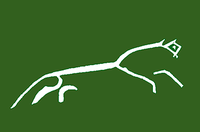Uffington White Horse
2007 Schools Wikipedia Selection. Related subjects: Ancient History, Classical History and Mythology
| Whitehorse Hill | |
|---|---|
 The White Horse as seen from an altitude of 700 metres |
|
| Elevation | 261 m (856 ft) |
| Location | Oxfordshire, England |
| Prominence | 79 m |
| Topo map | OS Landranger 174 |
| OS grid reference | SU301866 |
| Listing | County Top |
The Uffington White Horse is a highly stylised hillfigure, 374 feet (110 m) long, cut out of the turf on the upper slopes of Uffington Castle, a largely Iron Age hill fort near The Ridgeway, in the civil parish of Uffington in the English county of Oxfordshire (formerly Berkshire). It is located some five miles (eight kilometres) west of the town of Wantage. The hill upon which the figure is drawn is called White Horse Hill and the hills immediately surrounding it, the White Horse Hills.
History of the figure
The figure has been shown to date back some 3,000 years, to the Bronze Age, based on optically stimulated luminescence dating carried out following archaeological investigations in 1994. These studies produced three dates ranging between 1400 and 600 BC. Numerous other prominent prehistoric sites are located nearby, notably Wayland's Smithy, a long barrow less than two kilometres to the west.
The cutting exposes the underlying chalk making the horse a striking figure. Up until the late 19th century the horse was scoured every seven years as part of a more general local fair held on the hill. However, when the regular cleaning is halted the figure quickly becomes obscured. It has always needed frequent work, currently by English Heritage, for the figure to remain visible. Best views of the horse are obtained from the north, particularly from around the village of Great Coxwell.
It has long been debated whether the chalk figure is intended to represent a horse or some other animal. However, it has been called a horse since the eleventh century at least. An Abingdon cartulary, written by monks on vellum, between 1072 and 1084, refers to "mons albi equi" at Uffington ("the White Horse Hill").
The horse is thought to represent a tribal symbol perhaps connected with the builders of Uffington Castle. A more modern theory suggests that the stylised horse figure acted as a sign to people passing on The Ridgeway advertising horses being sold or catered for at the hillfort. It is quite similar to horses depicted on pre-Roman British coinage and the Marlborough bucket. For centuries, however, local people have maintained that it is a portrait of the dragon slain by Saint George on the nearby Dragon Hill.
The Blowing Stone, a perforated sarsen stone, which lies in a garden in Kingston Lisle, 2km away and which produces a note when blown through, is thought possibly to have been moved from the White Horse site, in 1750.
The steep sided dry valley below the horse is known as the Manger and legend says that the horse grazes there at night. Terraces at the bottom of this valley are the result of Medieval farming.
In August 2002, the figure was defaced with the addition of a rider and three dogs by members of the "Real Countryside Alliance" (Real CA). The act was denounced by the Countryside Alliance.
The Uffington Horse in popular culture
|
Map sources for the Uffington White Horse at grid reference SU301866
|
- G.K. Chesterton's poem The Ballad of the White Horse proposes a Christian interpretion to the continual scouring needed to maintain the impression in the chalk over the intervening millennia.
- Richard Doyle, a cartoonist and illustrator of Punch satirical magazine fame illustrated the 1859 book The Scouring of the White Horse by Thomas Hughes, the author of Tom Brown's School Days. The book mentions both the horse and the Blowing Stone.
- The design of the Uffington Horse was used as the album cover of the 1982 album English Settlement by English rock group XTC, who come from the nearby town of Swindon.
- The White Horse appears in the top right hand corner of the back of the Nirvana CD In Utero.
- It also featured in the 1992 Vincent Ward-directed movie Map of the Human Heart.
- It appears as a hill figure and as a silver necklace worn by Tiffany Aching in Terry Pratchett's Discworld novel, A Hat Full of Sky.
- The Uffington Horse is the symbol of Wessex Hall at the University of Reading, adopted in 1920 and still in use today.
- The Uffington White horse is often presentad as an image of Epona in popular works on Neopaganism, based on stylistic similarity with horses depicted on Iron Age British and Gaulish coinage; although the dating makes this very unlikely. There may also be an assumption that Epona statues depicted a white horse (the colour is unknown and this seems to be a confusion with Rhiannon).

